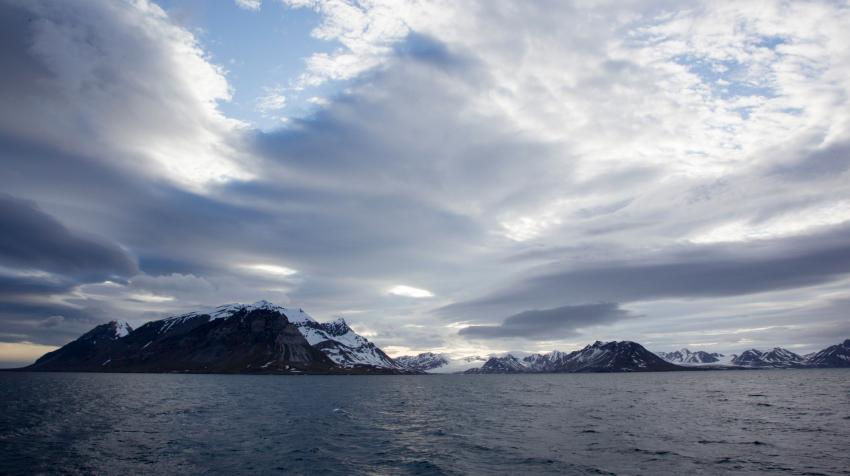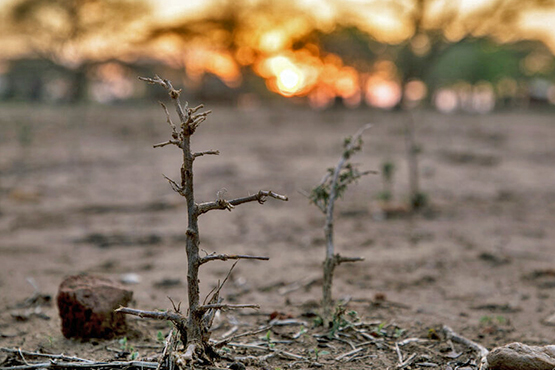Climate Change is the defining issue of our time and we are at a defining moment. From shifting weather patterns that threaten food production, to rising sea levels that increase the risk of catastrophic flooding, the impacts of climate change are global in scope and unprecedented in scale. Without drastic action today, adapting to these impacts in the future will be more difficult and costly.
The Human Fingerprint on Greenhouse Gases
Climate change refers to long-term shifts in temperatures and weather patterns. Such shifts can be natural, due to changes in the sun’s activity or large volcanic eruptions. But since the 1800s, human activities have been the main driver of climate change, primarily due to the burning of fossil fuels like coal, oil and gas.
Burning fossil fuels generates greenhouse gas emissions that act like a blanket wrapped around the Earth, trapping the sun’s heat and raising temperatures.
There are some basic well-established scientific links:
- The concentration of GHGs in the earth’s atmosphere is directly linked to the average global temperature on Earth;
- The concentration has been rising steadily, and mean global temperatures along with it, since the time of the Industrial Revolution;
- The most abundant GHG, accounting for about two-thirds of GHGs, carbon dioxide (CO2), is largely the product of burning fossil fuels.
The new Emissions Gas Report by the UN Environment Programme finds that there has been progress since the Paris Agreement was signed in 2015. Greenhouse gas emissions in 2030, based on policies in place, were projected to increase by 16 percent at the time of the agreement’s adoption. Today, the projected increase is 3 per cent. However, predicted 2030 greenhouse gas emissions still must fall by 28 per cent for the Paris Agreement 2°C pathway and 42 per cent for the 1.5°C pathway.
Climate-driven food and water insecurity is expected to grow
Global warming of 1.1°C above pre-industrial levels has been caused by over a century of burning fossil fuels and unequal, unsustainable energy and land use. This has led to an increase in the frequency and intensity of extreme weather events, which have caused dangerous impacts on nature and people worldwide.
Each increment of warming results in rapidly escalating hazards, such as more intense heatwaves, heavier rainfall, and other weather extremes that increase risks for human health and ecosystems. Climate-driven food and water insecurity is expected to increase with increased warming. When these risks combine with other adverse events, such as pandemics or conflicts, they become even more difficult to manage.
To close the gap between existing adaptation and what is needed, accelerated action to adapt to climate change is essential in this decade. Keeping warming to 1.5°C above pre-industrial levels requires deep, rapid, and sustained greenhouse gas emissions reductions in all sectors. Emissions should be decreasing by now and will need to be cut by almost half by 2030 if warming is to be limited to 1.5°C
The UN Intergovernmental Panel on Climate Change (IPCC)
The Intergovernmental Panel on Climate Change (IPCC) was set up by the World Meteorological Organization (WMO) and United Nations Environment to provide an objective source of scientific information.
Sixth Assessment Report
According to the Synthesis Report of the IPCC’s Sixth Assessment Report, there are multiple, feasible, and effective options to reduce greenhouse gas emissions and adapt to human-caused climate change, and they are available now. The IPCC proposes adopting a “climate-resilient development” that involves integrating measures to adapt to climate change with actions to reduce or avoid greenhouse gas emissions in ways that provide wider benefits.
For instance, access to clean energy and technologies can improve health, especially for women and children. Low-carbon electrification, walking, cycling, and public transport can enhance air quality, improve health, employment opportunities, and deliver equity. Economic benefits for people’s health from air quality improvements alone would be roughly the same, or possibly even larger than the costs of reducing or avoiding emissions.
Climate-resilient development becomes progressively more challenging with every increment of warming. Therefore, the choices made in the next few years will play a critical role in deciding the future of our planet and the generations to come.
To be effective, these choices need to be rooted in our diverse values, worldviews, and knowledges, including scientific knowledge, Indigenous Knowledge, and local knowledge. This approach will facilitate climate-resilient development and allow locally appropriate, socially acceptable solutions.
What we know based on the IPCC reports:
- It is unequivocal that human influence has warmed the atmosphere, ocean and land. Widespread and rapid changes in the atmosphere, ocean, cryosphere and biosphere have occurred.
- The scale of recent changes across the climate system as a whole – and the present state of many aspects of the climate system – are unprecedented over many centuries to many thousands of years.
- Approximately 3.3 to 3.6 billion people live in contexts that are highly vulnerable to climate change.
- Vulnerability of ecosystems and people to climate change differs substantially among and within regions.
- If global warming transiently exceeds 1.5°C in the coming decades or later, then many human and natural systems will face additional severe risks, compared to remaining below 1.5°C.
Global Warming of 1.5°C
In October 2018 the IPCC issued a special report on the impacts of global warming of 1.5°C, finding that limiting global warming to 1.5°C would require rapid, far-reaching and unprecedented changes in all aspects of society. With clear benefits to people and natural ecosystems, the report found that limiting global warming to 1.5°C compared to 2°C could go hand in hand with ensuring a more sustainable and equitable society. While previous estimates focused on estimating the damage if average temperatures were to rise by 2°C, this report shows that many of the adverse impacts of climate change will come at the 1.5°C mark.
The report also highlights a number of climate change impacts that could be avoided by limiting global warming to 1.5ºC compared to 2ºC, or more. For instance, by 2100, global sea level rise would be 10 cm lower with global warming of 1.5°C compared with 2°C. The likelihood of an Arctic Ocean free of sea ice in summer would be once per century with global warming of 1.5°C, compared with at least once per decade with 2°C. Coral reefs would decline by 70-90 percent with global warming of 1.5°C, whereas virtually all (> 99 percent) would be lost with 2ºC.
The report finds that limiting global warming to 1.5°C would require “rapid and far-reaching” transitions in land, energy, industry, buildings, transport, and cities. Global net human-caused emissions of carbon dioxide (CO2) would need to fall by about 45 percent from 2010 levels by 2030, reaching ‘net zero’ around 2050. This means that any remaining emissions would need to be balanced by removing CO2 from the air.
United Nations legal instruments
United Nations Framework Convention on Climate Change
The UN family is at the forefront of the effort to save our planet. In 1992, its “Earth Summit” produced the United Nations Framework Convention on Climate Change (UNFCCC) as a first step in addressing the climate change problem. Today, it has near-universal membership. The 197 countries that have ratified the Convention are Parties to the Convention. The ultimate aim of the Convention is to prevent “dangerous” human interference with the climate system.
Kyoto Protocol
By 1995, countries launched negotiations to strengthen the global response to climate change, and, two years later, adopted the Kyoto Protocol. The Kyoto Protocol legally binds developed country Parties to emission reduction targets. The Protocol’s first commitment period started in 2008 and ended in 2012. The second commitment period began on 1 January 2013 and ended in 2020. There are now 198 Parties to the Convention and 192 Parties to the Kyoto Protocol
.
Paris Agreement
At the 21st Conference of the Parties in Paris in 2015, Parties to the UNFCCC reached a landmark agreement to combat climate change and to accelerate and intensify the actions and investments needed for a sustainable low carbon future. The Paris Agreement builds upon the Convention and – for the first time – brings all nations into a common cause to undertake ambitious efforts to combat climate change and adapt to its effects, with enhanced support to assist developing countries to do so. As such, it charts a new course in the global climate effort.
The Paris Agreement’s central aim is to strengthen the global response to the threat of climate change by keeping the global temperature rise this century well below 2 degrees Celsius above pre-industrial levels and to pursue efforts to limit the temperature increase even further to 1.5 degrees Celsius.
On Earth Day, 22 April 2016, 175 world leaders signed the Paris Agreement at United Nations Headquarters in New York. This was by far the largest number of countries ever to sign an international agreement on a single day. There are now 194 countries that have ratified the Paris Agreement.
Nobel Peace Prize
In 2007, the Nobel Peace Prize was awarded jointly to former United States Vice-President Al Gore and the IPCC "for their efforts to build up and disseminate greater knowledge about man-made climate change, and to lay the foundations for the measures that are needed to counteract such change."
Resources
- UN Climate Action
- IPCC Sixth Assessment Report
- COP28
- Climate Ambition Summit 2023
- Sustainable Development Goal 13: Climate Action


